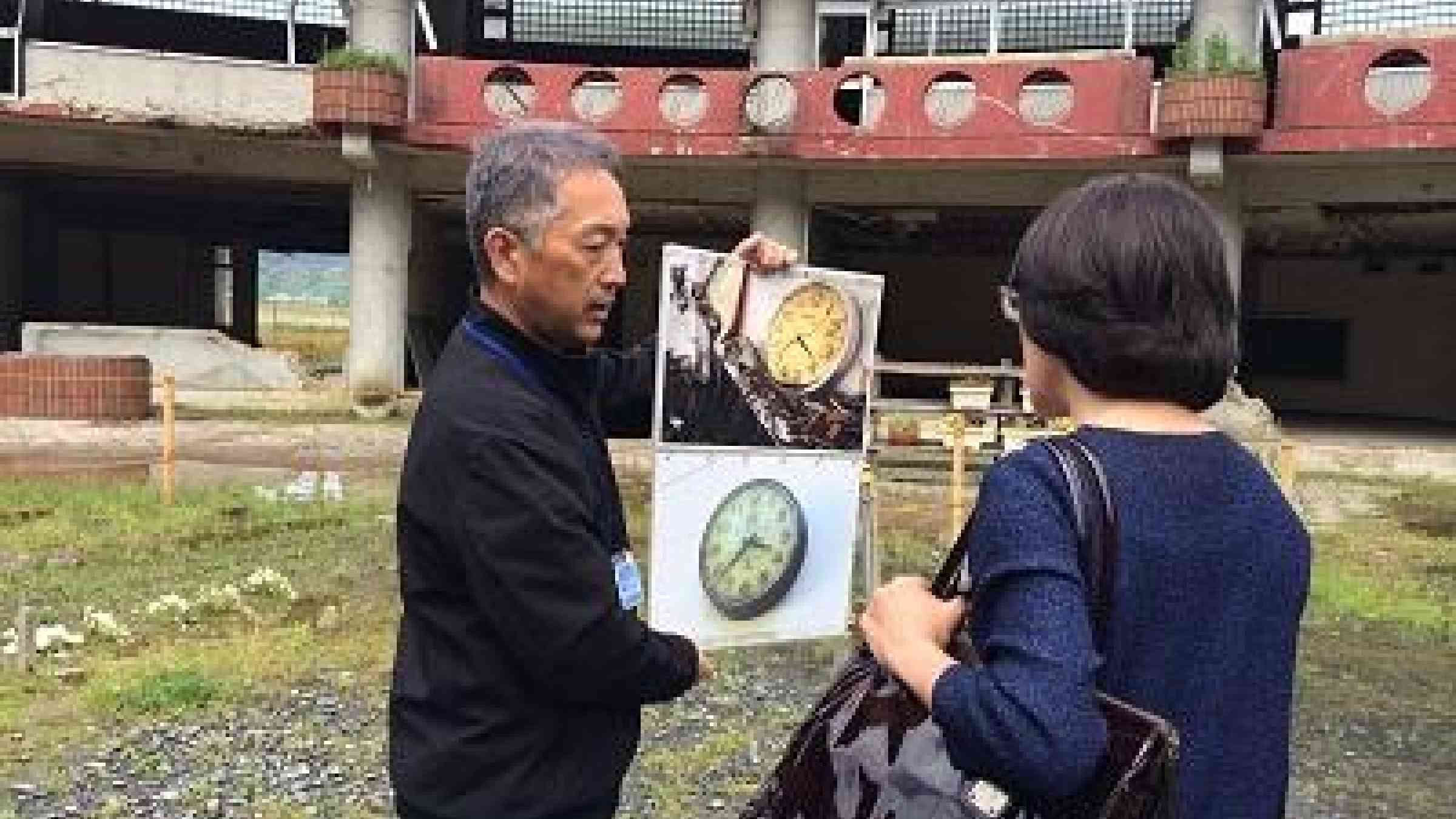UNISDR head visits tsunami schools

Noriyuki Suzuki who lost his daughter Mai in the 2011 tsunami shows UNISDR head, Mami Mizutori, a photo of the Okawa school clock which stopped at the time the tsunami hit. 74 children and ten teachers lost their lives at the school.
Kobe, 23 May, 2018 - Two schools with tragically different experiences of the 2011 Great East Japan Earthquake and Tsunami were at the centre of Ms. Mami Mizutori’s first visit to her native Japan since she took on the role of UN Special Representative for Disaster Risk Reduction in March.
Last Saturday, the head of UNISDR, Ms. Mizutori, was in the Tohoku region, where she visited Okawa Elementary School which lost 74 students and ten teachers in the tsunami that followed the magnitude 9 earthquake on March 11, 2011. In April this year, the Sendai High Court ruled that the deaths could have been prevented if a disaster contingency plan had been updated.
She heard the story of what happened on that day from Mr. Noriyuki Suzuki, who lost his daughter, Mai, a 6th grade student in the Okawa Elementary School.
“Learning from the tragedy that happened in this school, evacuation drills have to be practical and practiced regularly to save the lives of children. This tragic site should become a place where education for Bosai (disaster risk reduction in Japanese) should take place and spread a strong message to the world”, Mr. Suzuki said.
Ms. Mizutori also visited the Arahama Elementary School in Sendai City where all the students survived even though it was almost completely submerged in the tsunami. The site of the Arahama Elementary School was opened as a memorial facility in April 2017 where visitors can learn the story of how the 320 people including students, staff and local residents survived the tsunami. Many of them were rescued from the roof.
Their survival stories provide evidence of how preparedness measures put in place by the school worked. One year before the disaster, evacuation plans to the upper floors were revised and emergency goods were moved to the 3rd floor from the 1st floor.
"The Japanese word Kizuna means bonds or ties in a community. Kizuna in a community is critical for disaster risk reduction and building back better from disasters. This is something we have to foster through our daily life, not start trying for the first time when a disaster happens”, Ms. Mizutori said after meeting with groups of survivors.
She held three dialogues with children, women, and persons living with disabilities to emphasize the importance of inclusion in reducing disaster risk, a key guiding principle of the Sendai Framework for Disaster Risk Reduction 2015-2030, the global plan for reducing disaster losses adopted in Sendai, Japan, in March 2015.
Meeting in Sendai City with persons living with disability, she heard from one of them, Prof. Kazuhiko Abe of Tohoku Fukushi University. Prof. Abe said: “We should not rely only on the support provided by a public authority. We have to build resilience within ourselves and to reach out beyond our own group, which will lead to enhancing our capacity of self-help and mutual support”.
Ms. Mizutori’s dialogue with children and youth was held at a children’s center in Ishinomaki City which was opened in January 2014 as the result of recovery activities led by children and youth who proudly introduced the center which they designed.
Tsunami survivor, Hina (16) said: “It is important for us to share our experiences with our own words, not leaving the important task only to adults”.
Ayane (20) who experienced the disaster when she was in 6th grade, said: “I have realized the importance of sharing these experiences with other countries when I stayed in Fiji where people were not so prepared for an approaching cyclone.”
In a dialogue with women who demonstrated leadership in the restoration of housing, Ms. Mizutori was told “a sense of ownership has turned out to be very important for re-building our community through this project.”
Mr. Teruo Konno from Ishinomaki City government said there was successful collaboration between women in the community and the municipality with support from experts. “It was evident for me that gathering men only in the community could not reach any conclusion in the important discussion for their future community. Women’s practical and realistic thinking towards concrete solutions made a difference in this recovery project,” he said.
Ms. Mizutori also had a series of high level meetings with the Government of Japan, including Mr. Hachiro Okonogi, Minister for Disaster Management, Mr. Taro Kono, Minister for Foreign Affairs, and a group of parliamentarians including Mr. Toshihiro Nikai, Mr. Tatsuo Hirano, and Mr. Teru Fukui, Mr. Toshizo Ido, Governor of Hyogo Prefecture, Ms. Kazuko Kohri, Mayor of Sendai City, Mr. Shinichi Kitaoka, President of Japan International Cooperation Agency (JICA), and Mr. Yohei Sasakawa, Chairman of Nippon Foundation. She also met with representatives from civil society groups including science and technology, private sector and NGOs who are working on disaster risk reduction and resilience.
Explore further
Also featured on
Is this page useful?
Yes No Report an issue on this pageThank you. If you have 2 minutes, we would benefit from additional feedback (link opens in a new window).